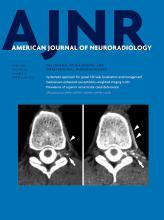Index by author
Guo, W.-Y.
- NeurointerventionYou have accessMorphologic Change of Flow-Related Aneurysms in Brain Arteriovenous Malformations after Stereotactic RadiosurgeryY.-S. Tsuei, C.-B. Luo, L.-Y. Fay, H.-C. Yang, W.-Y. Guo, H.-M. Wu, W.-Y. Chung and M.M.H. TengAmerican Journal of Neuroradiology April 2019, 40 (4) 675-680; DOI: https://doi.org/10.3174/ajnr.A6018
Haussen, D.C.
- NeurointerventionYou have accessAneurysm Remnants after Flow Diversion: Clinical and Angiographic OutcomesT.P. Madaelil, J.A. Grossberg, B.M. Howard, C.M. Cawley, J. Dion, R.G. Nogueira, D.C. Haussen and F.C. TongAmerican Journal of Neuroradiology April 2019, 40 (4) 694-698; DOI: https://doi.org/10.3174/ajnr.A6010
Haw, C.
- EDITOR'S CHOICENeurointerventionYou have accessImaging-Guided Superior Ophthalmic Vein Access for Embolization of Dural Carotid Cavernous Fistulas: Report of 20 Cases and Review of the LiteratureM.K.S. Heran, D. Volders, C. Haw and J.R. ShewchukAmerican Journal of Neuroradiology April 2019, 40 (4) 699-702; DOI: https://doi.org/10.3174/ajnr.A5994
In this retrospective study of 20 patients, the authors report the results of imaging-guided percutaneous superior ophthalmic vein access in dural carotid cavernous fistula treatment. Minimally invasive percutaneous imaging-guided access to the SOV can be obtained in situations in which conventional transvenousaccess to the cavernous sinus is not possible for managementof patients with dural carotid cavernous fistula. The authors conclude that direct imaging-guidedpercutaneous SOV access is a valuable and time-savingalternative route compared with direct surgical SOV access.
Heran, M.K.S.
- EDITOR'S CHOICENeurointerventionYou have accessImaging-Guided Superior Ophthalmic Vein Access for Embolization of Dural Carotid Cavernous Fistulas: Report of 20 Cases and Review of the LiteratureM.K.S. Heran, D. Volders, C. Haw and J.R. ShewchukAmerican Journal of Neuroradiology April 2019, 40 (4) 699-702; DOI: https://doi.org/10.3174/ajnr.A5994
In this retrospective study of 20 patients, the authors report the results of imaging-guided percutaneous superior ophthalmic vein access in dural carotid cavernous fistula treatment. Minimally invasive percutaneous imaging-guided access to the SOV can be obtained in situations in which conventional transvenousaccess to the cavernous sinus is not possible for managementof patients with dural carotid cavernous fistula. The authors conclude that direct imaging-guidedpercutaneous SOV access is a valuable and time-savingalternative route compared with direct surgical SOV access.
Hernandez-lain, A.
- Adult BrainOpen AccessMorphologic Features on MR Imaging Classify Multifocal Glioblastomas in Different Prognostic GroupsJ. Pérez-Beteta, D. Molina-García, M. Villena, M.J. Rodríguez, C. Velásquez, J. Martino, B. Meléndez-Asensio, Á. Rodríguez de Lope, R. Morcillo, J.M. Sepúlveda, A. Hernández-Laín, A. Ramos, J.A. Barcia, P.C. Lara, D. Albillo, A. Revert, E. Arana and V.M. Pérez-GarcíaAmerican Journal of Neuroradiology April 2019, 40 (4) 634-640; DOI: https://doi.org/10.3174/ajnr.A6019
Hill, M.D.
- NeurointerventionOpen AccessClot Burden Score and Early Ischemia Predict Intracranial Hemorrhage following Endovascular TherapyV. Yogendrakumar, F. Al-Ajlan, M. Najm, J. Puig, A. Calleja, S.-I. Sohn, S.H. Ahn, R. Mikulik, N. Asdaghi, T.S. Field, A. Jin, T. Asil, J.-M. Boulanger, M.D. Hill, A.M. Demchuk, B.K. Menon and D. Dowlatshahi on behalf of the INTERRSeCT InvestigatorsAmerican Journal of Neuroradiology April 2019, 40 (4) 655-660; DOI: https://doi.org/10.3174/ajnr.A6009
Hojnacki, D.
- Adult BrainOpen AccessLeptomeningeal Contrast Enhancement Is Related to Focal Cortical Thinning in Relapsing-Remitting Multiple Sclerosis: A Cross-Sectional MRI StudyN. Bergsland, D. Ramasamy, E. Tavazzi, D. Hojnacki, B. Weinstock-Guttman and R. ZivadinovAmerican Journal of Neuroradiology April 2019, 40 (4) 620-625; DOI: https://doi.org/10.3174/ajnr.A6011
Howard, B.M.
- NeurointerventionYou have accessAneurysm Remnants after Flow Diversion: Clinical and Angiographic OutcomesT.P. Madaelil, J.A. Grossberg, B.M. Howard, C.M. Cawley, J. Dion, R.G. Nogueira, D.C. Haussen and F.C. TongAmerican Journal of Neuroradiology April 2019, 40 (4) 694-698; DOI: https://doi.org/10.3174/ajnr.A6010
Hsieh, B.-Y.
- Adult BrainOpen AccessBehavioral and Structural Effects of Single and Repeat Closed-Head InjuryY.-C.J. Kao, Y.W. Lui, C.-F. Lu, H.-L. Chen, B.-Y. Hsieh and C.-Y. ChenAmerican Journal of Neuroradiology April 2019, 40 (4) 601-608; DOI: https://doi.org/10.3174/ajnr.A6014
Hu, L.S.
- EDITOR'S CHOICEAdult BrainOpen AccessMoving Toward a Consensus DSC-MRI Protocol: Validation of a Low–Flip Angle Single-Dose Option as a Reference Standard for Brain TumorsK.M. Schmainda, M.A. Prah, L.S. Hu, C.C. Quarles, N. Semmineh, S.D. Rand, J.M. Connelly, B. Anderies, Y. Zhou, Y. Liu, B. Logan, A. Stokes, G. Baird and J.L. BoxermanAmerican Journal of Neuroradiology April 2019, 40 (4) 626-633; DOI: https://doi.org/10.3174/ajnr.A6015
DSC-MR imaging using preload, intermediate (60°) flip angle and postprocessing leakage correction has gained traction as a standard methodology. Simulations suggest that DSC-MR imaging with flip angle = 30° and no preload yields relative CBV practically equivalent to the reference standard. Eighty-four patients with brain lesions were enrolled in this 3-institution study. Forty-three patients satisfied the inclusion criteria. DSC-MR imaging (3T, single-dose gadobutrol, gradient recalled-echo–EPI, TE=20–35 ms, TR=1.2–1.63 seconds) was performed twice for each patient, with flip angle = 30°–35° and no preload (P-) or provided preload (P+) for an intermediate flipangle = 60°. Compared with 60°/P+/C+, 30°/P-/C+ had closest mean standardized relative CBV, highest Lin concordance correlation coefficient, and lowest Bland-Altman bias.








